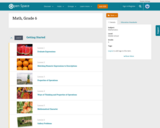
7 Results


Ratios
Type of Unit: Concept
Prior Knowledge
Students should be able to:
Calculate with whole numbers up to 100 using all four operations.
Understand fraction notation and percents and translate among fractions, decimal numbers, and percents.
Interpret and use a number line.
Use tables to solve problems.
Use tape diagrams to solve problems.
Sketch and interpret graphs.
Write and interpret equations.
Lesson Flow
The first part of the unit begins with an exploration activity that focuses on a ratio as a way to compare the amount of egg and the amount of flour in a mixture. The context motivates a specific understanding of the use of, and need for, ratios as a way of making comparisons between quantities. Following this lesson, the usefulness of ratios in comparing quantities is developed in more detail, including a contrast to using subtraction to find differences. Students learn to interpret and express ratios as fractions, as decimal numbers, in a:b form, in words, and as data; they also learn to identify equivalent ratios.
The focus of the middle part of the unit is on the tools used to represent ratio relationships and on simplifying and comparing ratios. Students learn to use tape diagrams first, then double number lines, and finally ratio tables and graphs. As these tools are introduced, students use them in problem-solving contexts to solve ratio problems, including an investigation of glide ratios. Students are asked to make connections and distinctions among these forms of representation throughout these lessons. Students also choose a ratio project in this part of the unit (Lesson 8).
The third and last part of the unit covers understanding percents, including those greater than 100%.
Students have ample opportunities to check, deepen, and apply their understanding of ratios, including percents, with the selection of problems in the Gallery.
- Subject:
- Mathematics
- Statistics and Probability
- Provider:
- Pearson

Students design and work on their projects in class. They review the project rubric and, as a class, add criteria relevant to their specific projects.Key ConceptsStudents apply their knowledge about ratios to solve a problem. They represent ratios using models such as tables, tape diagrams, double number lines, or graphs.Goals and Learning ObjectivesUse and interpret ratios to solve a problem.Model ratios—including tables, tape diagrams, double number lines, graphs—to represent a problem situation.Articulate strategies, thought processes, and approaches to solving a problem and defend why the solution is reasonable.
- Subject:
- Ratios and Proportions
- Material Type:
- Lesson Plan
- Author:
- Chris Adcock
- Date Added:
- 02/28/2022

This lesson introduces the concept of a glide ratio and encourages students to use appropriate tools strategically (Mathematical Practice 5). Students use tape diagrams, double number lines, ratio tables, graphs, and equations to represent glide ratios.Key ConceptsA glide ratio for an object or an organism in flight is the ratio of forward distance to vertical distance (in the absence of power and wind). For a given object or organism that glides, this ratio has a constant value and is treated as a feature of the object or organism.Goals and Learning ObjectivesUnderstand the concept of a glide ratio.Make connections within and between different ways of representing ratios.
- Subject:
- Ratios and Proportions
- Material Type:
- Lesson Plan
- Author:
- Chris Adcock
- Date Added:
- 02/28/2022

Students begin the lesson with a critique of their own work on the Self Check using questions and comments from you to reflect on their work. They then critique three examples of student work on the task, each with its own tools for modeling the given relationship between quantities. Finally, they apply what they learned to a closely related problem.Key ConceptsStudents reflect on their work and connect different ways of representing ratio relationships: tape diagrams, double number lines, and ratio tables.Goals and Learning ObjectivesUse teacher comments to refine solution strategies for ratio problems.Deepen understanding of ratio relationships.Synthesize and connect strategies for representing and investigating ratio relationships.Critique given student models created to solve ratio problems.Apply deepened understanding of ratio relationships to a new ratio problem.
- Subject:
- Ratios and Proportions
- Material Type:
- Lesson Plan
- Author:
- Chris Adcock
- Date Added:
- 02/28/2022

Students use tape diagrams to model relationships and solve problems about types of DVDs.Key ConceptsTape diagrams are useful for visualizing ratio relationships between two (or more) quantities that have the same units. They can be used to highlight the multiplicative relationship between the quantities.Goals and Learning ObjectivesUnderstand tape diagrams as a way to visually compare two or more quantities.Use tape diagrams to solve ratio problems.
- Subject:
- Ratios and Proportions
- Material Type:
- Lesson Plan
- Author:
- Chris Adcock
- Date Added:
- 02/28/2022

Practice solving ratio word problems like, "If Ben reads 10 pages in 15 minutes, how long does it take him to read 40 pages?" Students receive immediate feedback and have the opportunity to try questions repeatedly, watch a video or receive hints.
Khan Academy learning modules include a Community space where users can ask questions and seek help from community members. Educators should consult with their Technology administrators to determine the use of Khan Academy learning modules in their classroom. Please review materials from external sites before sharing with students.
- Subject:
- Mathematics
- Material Type:
- Audio/Video
- Lesson
- Provider:
- Khan Academy
- Date Added:
- 11/14/2023